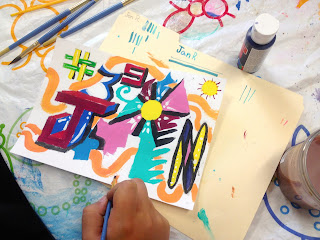In order to for future elementary and
secondary educators to generate arts integrated lessons, I researched about
three dozen websites that had cross content and art integrated lesson plans.
Most incorporate only one form of art so as educators we’ll need to combine
lessons and/or expand the lessons on our own to incorporate more CRISPA
aspects. I have separated the websites that I thought the most helpful in two
categories. The first grouping contains sites that have easily navigable lesson
plans ideas where you typically can put in a content area, such as math or
science for instance, and then select an art form that you would like to
integrate although some sites only
have visual or language art integration and not music, theatre and dance. The
second grouping is not a list of “go to” sites with an abundance of specific lesson plans, but nonetheless are valuable
resources providing tips and strategies for art integration and multi-sensory
education.
Group One ~ Lesson Plan Ideas
The
Denver Art Museum http://creativity.denverartmuseum.org/
This is
the website that was presented to us at DAM on Thursday.
As part
of the national Art Education Association (NAEA), Artsonia is an online gallery
of student artwork and lesson plans. You need to sign up for this site but it
is free. You can also submit your own lesson plans to share in the Artsonia
community.
Edutopia
does offer ideas and lesson plans that also integrate dance, language and
visual arts providing common core standards and objectives, as well as provide
templates to create your own.
Education
Closet http://educationcloset.com/
Education
Closet is an easy to navigate site that has lesson plans that incorporate
dance, music, drama, and visual arts as well as strategies and articles that
can deepen your knowledge and understanding of art integration and its
benefits.
Lesson
Plans Page http://lessonplanspage.com/
Combine
contents and grade to get several samples of lessons in most cases. The lessons
that do come up are generally very thorough with objectives, instructions, materials
and time needed, etc. Although not all of them are specifically aligned with
the common core standards, many of them do specify the standards.
Arts
Integration Grant
This site
has many lessons that incorporate language and visual arts, music, dance,
theatre into math, science social studies and history as well as other useful
information.
Currently,
there are 187 different lessons integrating theatre, dance, music, literary,
media or visual arts to several other contents including physical education,
technology and geography. The lessons are comprehensive providing an overview
with learning objectives, preparation information, instruction steps, and
standards included in the lesson.
Group
Two ~ Art Integration & Multi-Sensory Resources
Artful Thinking http://www.pzartfulthinking.org/overview.php
Mentioned by DAM presenter on
Thursday, Artful Thinking is the Harvard developed program that believes
incorporating works of visual art and music in curriculum strengthen student
thinking and learning.
A clean, easy site that
offers research information on incorporating visual art, dance/movement and theatre/drama
into education and offers templates for creating your own. However, the lesson
plan samples portion is a bit thin.
Dick
Blick http://www.dickblick.com/lesson-plans/
A popular
artists material resource site, Dick Blick also has hundreds of lessons
although they are not specifically organized by cross content information.
Rather this site can be used for general visual art ideas as well as artists
materials to purchase.
Lesson
Planet http://www.lessonplanet.com/
This site
costs $4.99 per month but claims to have over 400,000 lesson plans and new
ideas for cross-curricular lessons.
Art21 is
a PBS produced and broadcasted seven season series of art in the twenty-first
century specifically created for educators. Educators' Guides support the use of contemporary art in
classroom and community settings by empowering educators to explore the
artists, ideas, and themes being explored in art today, and encouraging them to
interpret these ideas for individual student needs. The Educators Guide and
additional online content introduce opportunities for critical thinking and
creative problem solving relevant to middle-school, high-school, and college
students. The content can be easily adapted for younger or older groups. Guides
include additional information about each of the artists, as well as Before
Viewing, During Viewing, and After Viewing questions and suggestions for
hands-on activities. These suggestions are interdisciplinary and support
various subject areas, including the Visual and Performing Arts, Language Arts,
and Social Studies.
Download and
customize slide shows, worksheets, and other resources for use in the classroom
or for independent study of famous artists and works of art and the themes they
explored. This is a site to use as a resource and ideas but does not contain
lesson plans.












































